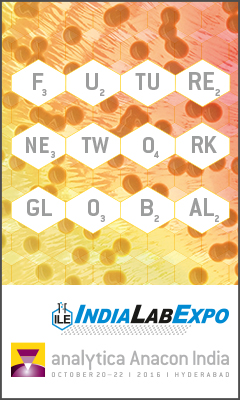|
L&Mint-int-1-2013
Chemical synthesis of vaccinesAn anti-cancer jab? - von Prof. Dr Horst Kunz, Sebastian Hartmann, Björn PalitzschFood safety: new approaches to analysisSure, it tastes good - von Prof. Dr Dr Alfonso Lampen, Dr Thorsten Buhrke, Hermann Broll
Food safety is a requirement stipulated by Section 14 of EU Basic Regulation (EC) No. 178/2004. Food safety monitoring activities conducted by state inspection agencies ensure nationwide compliance with the high levels of food safety in Germany. As well as monitoring microbial loads in foodstuffs, the agencies also focus on a wide range of chemical contaminants, such as dioxins. Whether the foodstuffs have been contaminated with these kinds of potentially...
 Instrumental and effect-directed analysis in the oxidative degradation of micropollutantsPharmaceuticals in wastewater - von Dr Jochen Türk
Occurance and fate of micropollutants, metabolites and transformation products in the water cycle is placing increasingly higher demands on instrumental analysis in terms of resolution and sensitivity. As yet, effect-directed analysis methods play a subordinate role in water analysis work. Yet for evaluating unknown samples or ingredients, these methods form a perfect complement to instrument-based identification. Indeed, in the detection of estrogenically...
 More reproducible retention timesBest HPLC-Chromatograms - von Dr Andrea Junker-Buchheit
The high health hazard potential of many organic solvents is well known to anyone working in a laboratory. Solvent vapours can not only endanger people’s health, but also increase the fire and explosion risks for laboratories and buildings, in addition to causing air pollution. This is also the case for analytical and preparative HPLC laboratories.
 Mysterious mycoplasma – a question of culture?!
Firstly reported in 1956 (Robinson et al. 1956), the potential presence of mycoplasma in cell culture laboratories challenges scientists. The parasitic mycoplasmas represent a serious problem for all cell line-related fields in research as well as in industrial facilities for development or manufacture of cell-derived biological and pharmaceutical products, including vaccines, monoclonal antibodies, drugs, and products for gene and cell therapy. Still,...
 New highly expandable platform for live cell imagingA Higher Level of Live Cell Research
Designed with the scientist’s workflow in mind the innovative new IX3 series of inverted research microscope systems from Olympus are developed for effortless, intuitive live cell imaging and clinical analysis. Built using worldwide customer feedback and designed to meet the needs of a wide range of users, the new systems offer exceptional ease-of-use and unprecedented optical flexibility via a new, customisable light path. New components can...
 The theory behind biological trace analysisA Spring Without Birdsong - von Prof. Dr Bernd Herrmann
In 1962, biologist Rachel Carson published her world-famous book “Silent Spring”, in which she warned of the consequences of inconsiderate use of DDT. DDT accumulates in the food chain and, thanks to its hormone-mimicking effects, causes serious damage to the organisms at the end of such food chains. One such effect is that the shells of many birds’ eggs become so thin that they break during incubation. The consequence: a silent spring without...
 |
L&M int. 1 / 2013
|















